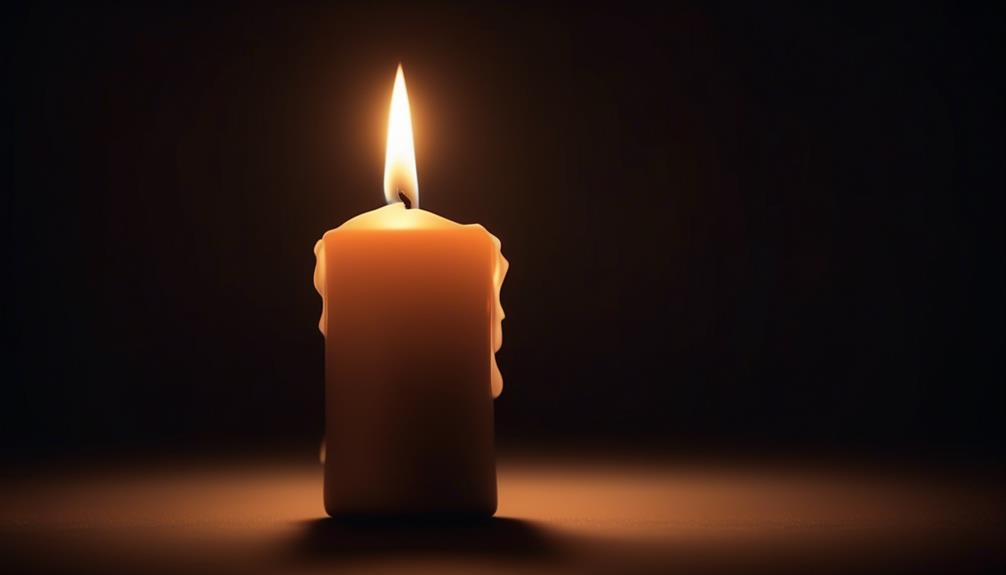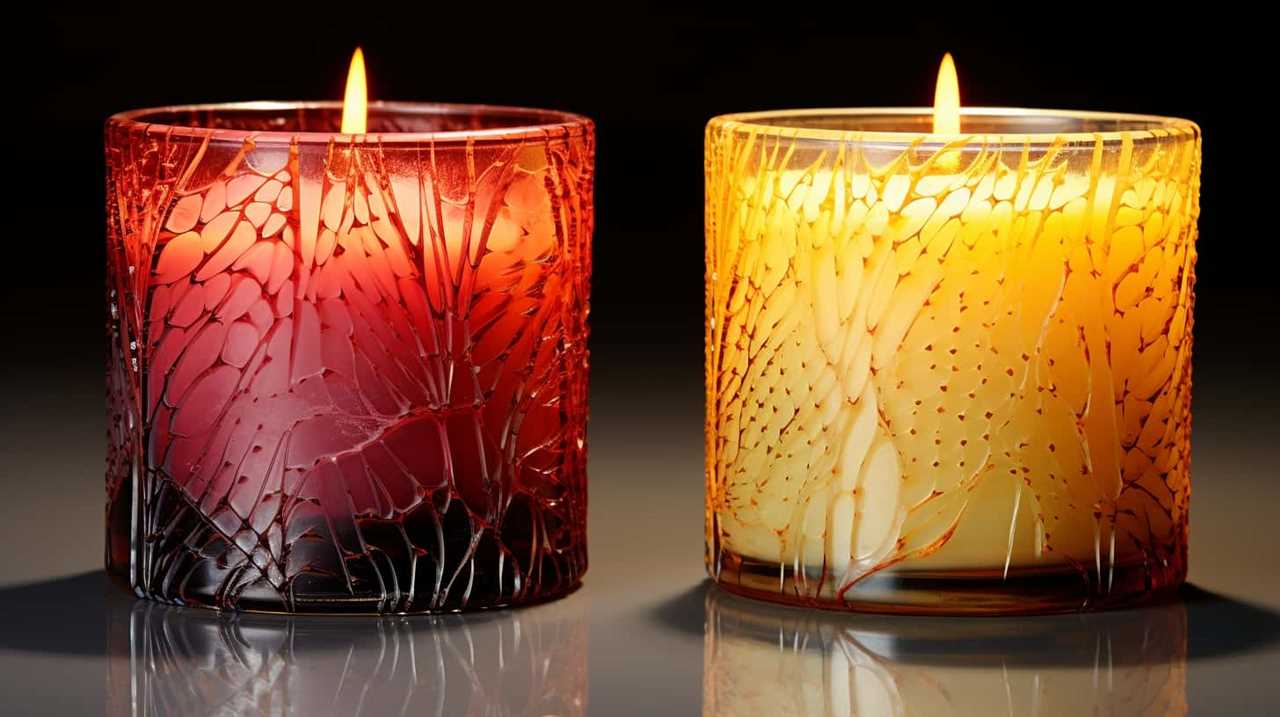Hello, valued readers, we appreciate you joining us as we explore the captivating history of candles!
Today, we invite you to discover the lesser-known historical usage of candles throughout the ages. Did you know that candles have their origins in prehistoric times? Yes, well before the advent of electricity, our ancestors relied on the warm glow of candlelight to illuminate their surroundings.
From the ancient Egyptians’ sacred rituals to the Romans’ intimate candlelit dinners, candles have played a significant role in various cultures and time periods. Join us as we explore the intriguing ways candles were utilized in medieval ecclesiastical settings, adorned in Renaissance decor, and incorporated into modern interior design.
Along the way, we will also delve into the manufacturing techniques, environmental impact, and the future of candle usage.

So, let us embark on this illuminating journey together, shall we?
Key Takeaways
- Candles have a long history of use, dating back to prehistoric times when animal fat was used as wax for making candles.
- Candles played a significant role in ancient Egyptian rituals and religious ceremonies, as well as in Roman social gatherings and religious rituals.
- During the Renaissance, decorative candles were highly valued for their ability to create a warm and inviting atmosphere in homes and palaces.
- The candle-making industry stimulated the growth of ancillary industries and contributed to the economy, but the popularity of candles declined with the introduction of electricity and cheaper lighting options in the early 20th century.
Prehistoric Origins
In exploring the historical usage of candles through the ages, we begin with their prehistoric origins. The earliest known source of wax for making candles in prehistoric times was animal fat. Ancient civilizations would collect fats from animals, such as beef or sheep, and render them to obtain the wax-like substance necessary for candle making. These early candle making techniques involved dipping a wick into the melted animal fat and allowing it to harden, creating a simple source of light. This method of candle making was essential for providing illumination in caves and other dark spaces, enabling our ancestors to navigate and perform daily tasks.
Transitioning into the subsequent section about ancient Egyptian illumination, we can see how the use of candles evolved over time.
Ancient Egyptian Illumination
Moving on from their prehistoric origins, ancient Egyptians also utilized candles for illumination. Candles played a significant role in Egyptian rituals and were used in various ancient lighting techniques.

These candles, known as rushlights, were made by soaking a rush pith in animal fat or vegetable oil. The rush pith acted as the wick, and the fat or oil provided the fuel for the flame. The flame emitted a warm and steady light, creating a serene ambiance during religious ceremonies and rituals.
Additionally, candles were used to light up the homes of the wealthy and elite, adding a touch of luxury to their surroundings.
The ancient Egyptians’ innovative use of candles showcases their advanced understanding of lighting techniques and their desire to create an atmosphere of beauty and reverence.
Roman Candlelight
Continuing our exploration of historical candle usage, let’s delve into the fascinating realm of Roman candlelight. During the Roman Empire, candles were used extensively for both practical and symbolic purposes. Here are some interesting aspects of Roman candlelight:
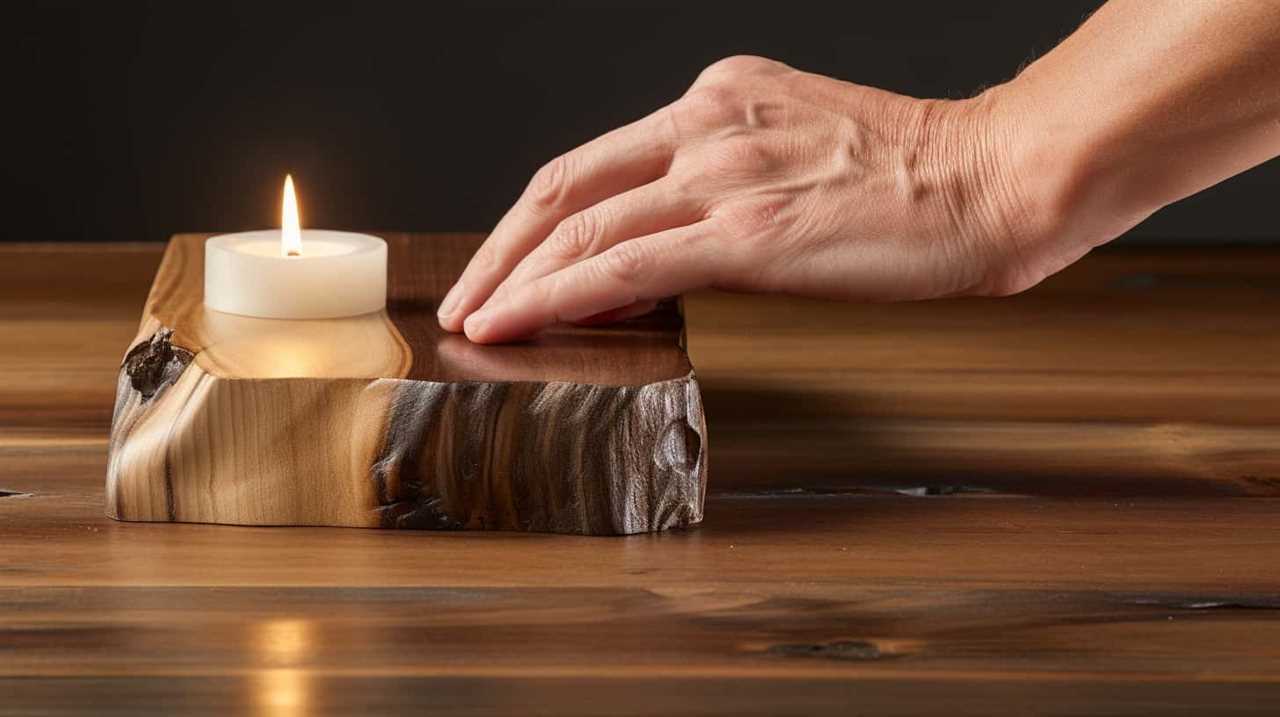
- Social gatherings: Roman elites used candles to create an inviting atmosphere during their lavish banquets and parties, enhancing the ambiance and setting the mood for the evening.
- Religious ceremonies: Candles played a significant role in Roman religious rituals, symbolizing divine presence and purity. They were lit to honor gods and goddesses, creating a sacred atmosphere.
- Funerals: Candles were used during funeral processions and burials to symbolize the transition from life to death. The flickering flame represented the soul’s journey to the afterlife.
- Symbolism in candlelight: Roman candlelight held deeper meanings, representing enlightenment, knowledge, and hope. The gentle glow of the flame symbolized illumination of the mind and the pursuit of truth.
Roman candlelight not only served practical purposes but also held symbolic significance in various aspects of Roman society.
Medieval Ecclesiastical Use
Transitioning from the fascinating realm of Roman candlelight, we now delve into the medieval ecclesiastical use of candles.
In medieval religious ceremonies, candles played a significant role as symbols of light and spirituality. These ceremonies, conducted by the clergy, were filled with symbolism and ritualistic practices.
Candles were used to represent the presence of God and to create a sacred atmosphere. The flickering flame was seen as a representation of the divine light illuminating the darkness of the world.
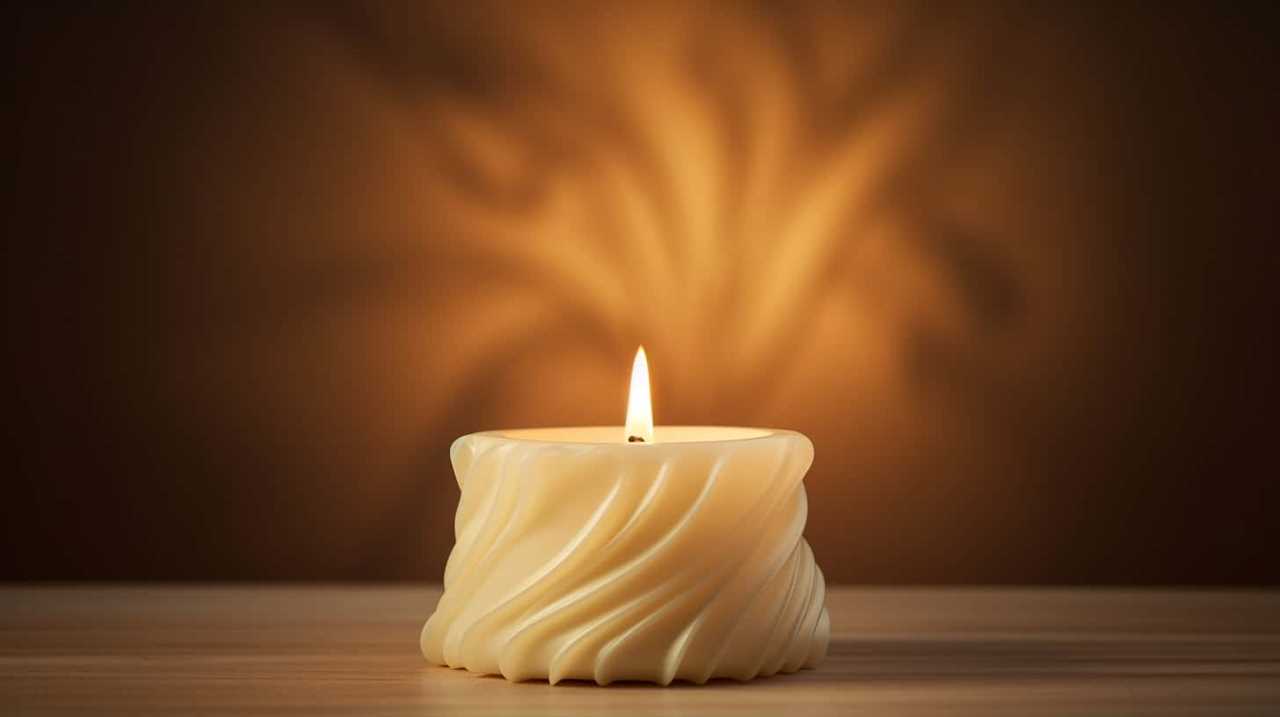
The use of candles in these ceremonies served as a visual reminder of the spiritual journey and the importance of seeking enlightenment. The symbolism of candles continues to be an integral part of religious practices today, reminding us of the power of light and the divine presence.
Renaissance Decorative Candles
During the Renaissance, decorative candles adorned homes and palaces, adding a touch of elegance and opulence to the surroundings. Candlelight was highly valued for its ability to create a warm and inviting atmosphere.
Renaissance candle holders were crafted with intricate designs, often made from precious metals such as silver or gold. These candle holders not only served as functional pieces, but also as exquisite works of art, showcasing the wealth and status of the homeowner.
The use of candles also held symbolic meaning during this time. Candlelight was associated with enlightenment, knowledge, and spirituality, as well as a representation of the divine presence.

In addition, the flickering flame of a candle was believed to ward off evil spirits and bring blessings to the household.
Colonial American Lighting
In Colonial America, candles played a crucial role in lighting homes and public spaces. Candle-making techniques were passed down through generations, allowing colonists to create their own candles using locally available resources such as tallow or beeswax.
The economic impact of candle production was significant, as it provided opportunities for trade and commerce within the colonies.
Candle-Making Techniques
We learned how to craft candles using traditional techniques during our exploration of Colonial American lighting. Candle-making in the colonial era required a deep understanding of the materials and processes involved. Here are some key points we discovered:
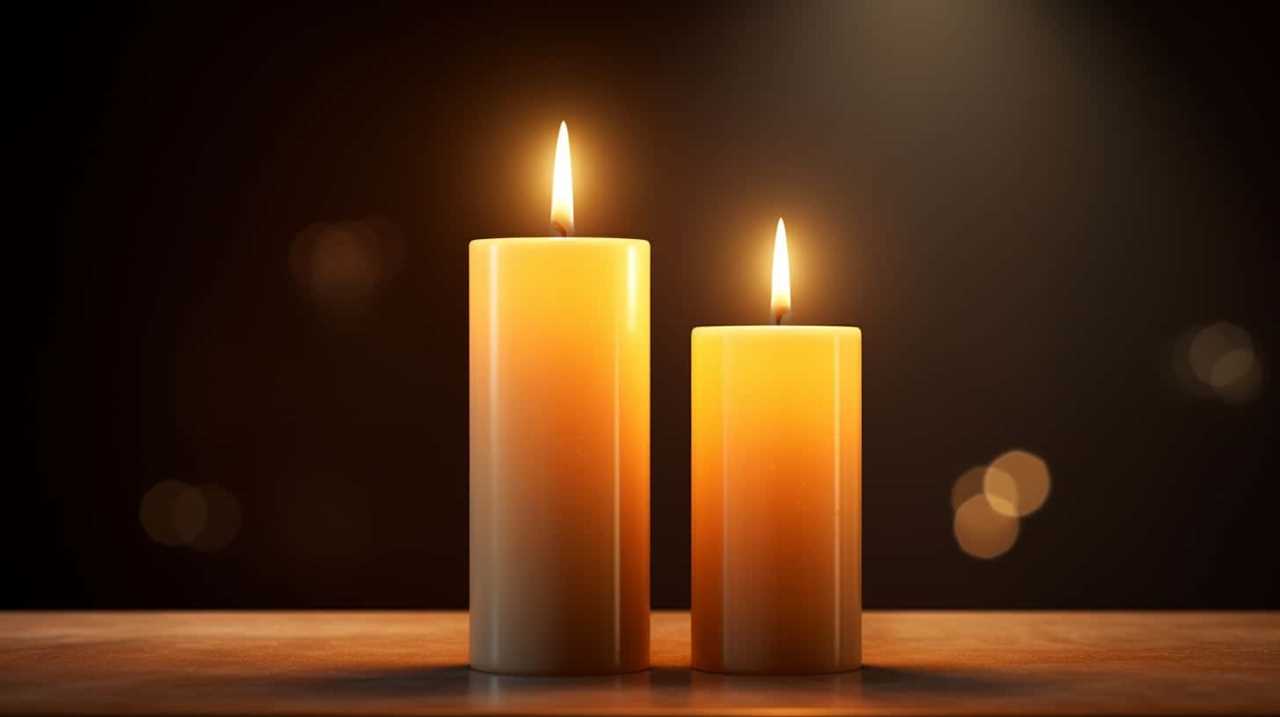
- Traditional vs. Modern Techniques:
- Colonial candle-making involved dipping wicks repeatedly into melted tallow or beeswax, building up layers gradually.
- Modern techniques, on the other hand, often utilize molds and machinery for mass production.
- Sustainability in Candle Making:
- Colonial candle-making relied on locally sourced materials like animal fats and beeswax, making it a sustainable practice.
- In modern candle-making, sustainability is increasingly emphasized, with the use of renewable resources like soy wax and cotton wicks.
Role in Daily Life
Candles were an essential part of our daily lives in Colonial America, providing us with a reliable source of light. They were not only used for practical purposes but also played a significant role in celebrations and offered therapeutic benefits. Candles were often used to mark important occasions such as birthdays, weddings, and religious ceremonies, creating a warm and inviting atmosphere. Their soft, flickering light added a sense of coziness and intimacy to these special events. Additionally, the gentle glow of candles had a calming effect on our minds and bodies, helping us relax and unwind after a long day. Whether it was lighting up our homes or bringing joy to festive occasions, candles held a vital place in our daily lives, offering both practical and emotional support.
| Role in Daily Life (Colonial American Lighting) |
|---|
| – Provided reliable source of light |
| – Used in celebrations to create ambiance |
| – Offered therapeutic benefits |
Economic Impact
During Colonial America, candles had a significant economic impact on our society, contributing to various industries and providing employment opportunities. The impact on the economy was evident through the following market trends:
- Increased demand for raw materials: The production of candles required large quantities of tallow, beeswax, and other ingredients. This led to a surge in the demand for these materials, benefiting suppliers and creating a thriving market.
- Growth of candle-making industry: The economic impact of candles extended to the candle-making industry itself. As the demand for candles soared, candle makers enjoyed sustained business and expanded their operations, leading to job creation and economic growth.
- Trade and export opportunities: Colonial America became a major exporter of candles, supplying neighboring colonies and even other countries. This trade contributed to the growth of the economy and helped establish a favorable balance of trade.
- Support for related industries: The candle industry stimulated the growth of ancillary industries, such as wick production, candle molds, and candlestick manufacturing. These industries flourished alongside the candle-making industry, further bolstering the economy.
The economic impact of candles during Colonial America was far-reaching, creating opportunities, driving market trends, and contributing to the overall growth of the economy.
Industrial Revolution Innovation
During the Industrial Revolution, candles played a significant role in the manufacturing industry. The development of machinery and the use of steam power led to increased production and efficiency. Technological advancements in candle-making, such as the introduction of automated dipping machines, further revolutionized the industry.
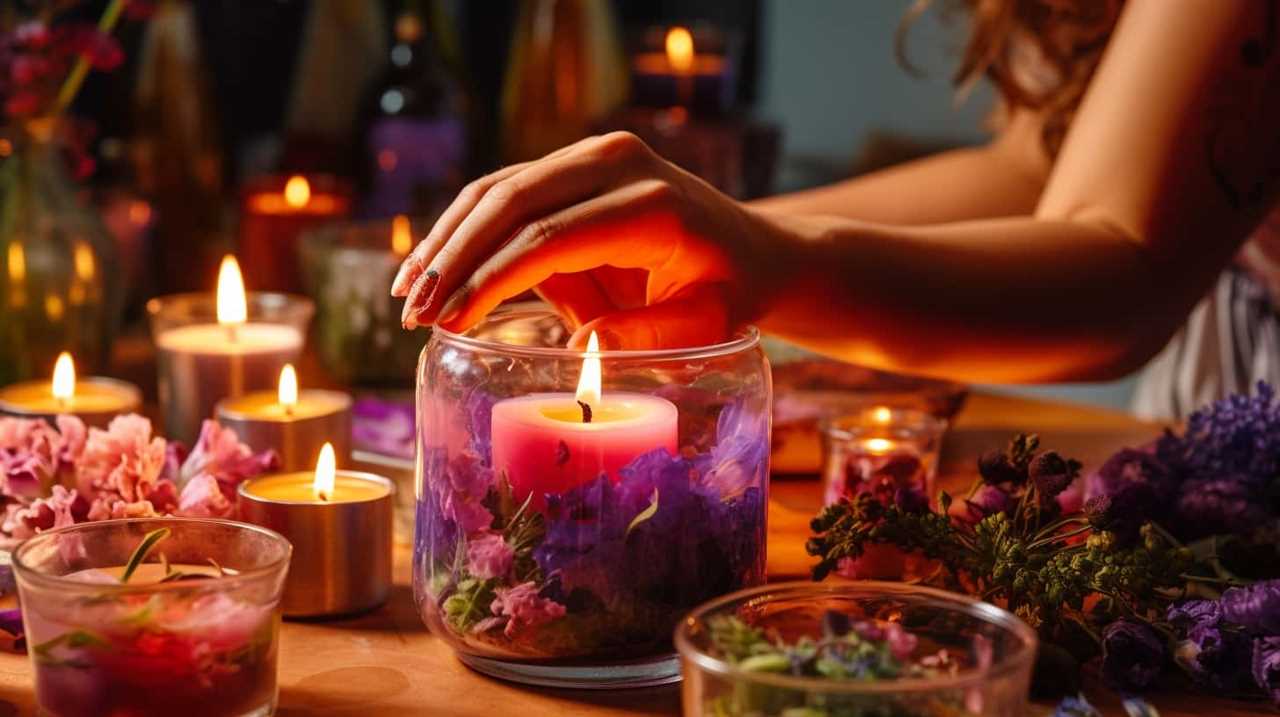
Additionally, the rise of urbanization during this time created a high demand for candles in cities, where they were used for lighting and as a source of heat.
Impact on Manufacturing
Throughout history, the usage of candles has had a significant impact on manufacturing, revolutionizing industrial processes during the Industrial Revolution. Here are some key ways in which candles influenced manufacturing:
- Increased productivity: Candles provided a reliable and portable source of light, enabling workers to extend their working hours and increase productivity in factories and workshops.
- Improved safety: Before the invention of electric lighting, candles were crucial in preventing accidents caused by inadequate lighting, reducing the risk of injuries and improving overall safety in manufacturing environments.
- Enhanced precision: The steady flame of candles allowed workers to perform delicate tasks with greater accuracy, leading to improved quality and precision in the production of goods.
- Expanded market reach: The availability of affordable candles made it possible for industries to operate in areas without access to natural light, expanding the reach of manufacturing and boosting local economies.
These advancements in manufacturing, driven by candle usage, set the stage for the technological advancements during…
Technological Advancements During
We witnessed remarkable technological advancements in innovation during the Industrial Revolution. These advancements had a significant impact on manufacturing, revolutionizing the way goods were produced.
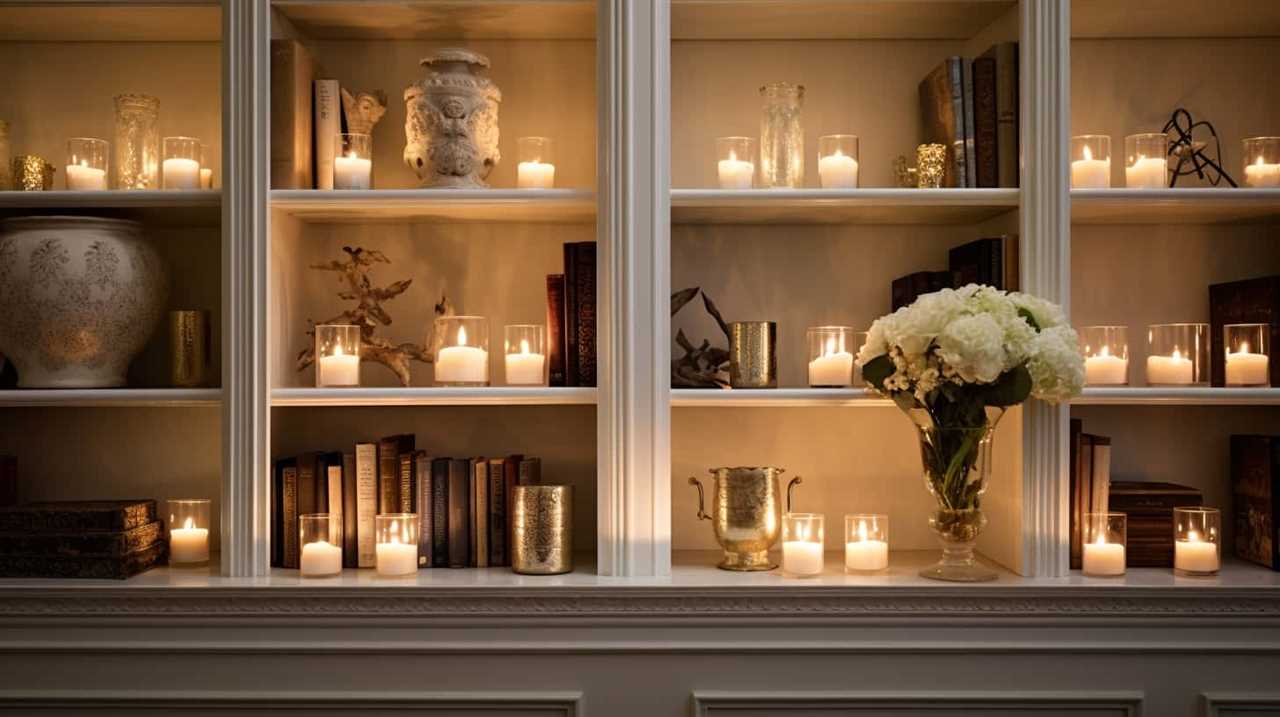
The introduction of new machinery and processes greatly increased productivity and efficiency, leading to the mass production of goods on an unprecedented scale. The invention of steam-powered machinery, such as the steam engine and the power loom, transformed the textile industry, allowing for faster and more consistent production of fabrics.
Additionally, the development of new transportation technologies, such as the steam locomotive, revolutionized the way goods were transported, making it easier and faster to distribute products across vast distances.
These technological advancements during the Industrial Revolution laid the foundation for modern manufacturing practices, shaping the world we live in today.
Role in Urbanization
The Industrial Revolution’s technological advancements played a pivotal role in urbanization by shaping the way cities developed and grew. During this period of rapid industrialization, candles had a significant impact on urban life and the overall economic landscape.
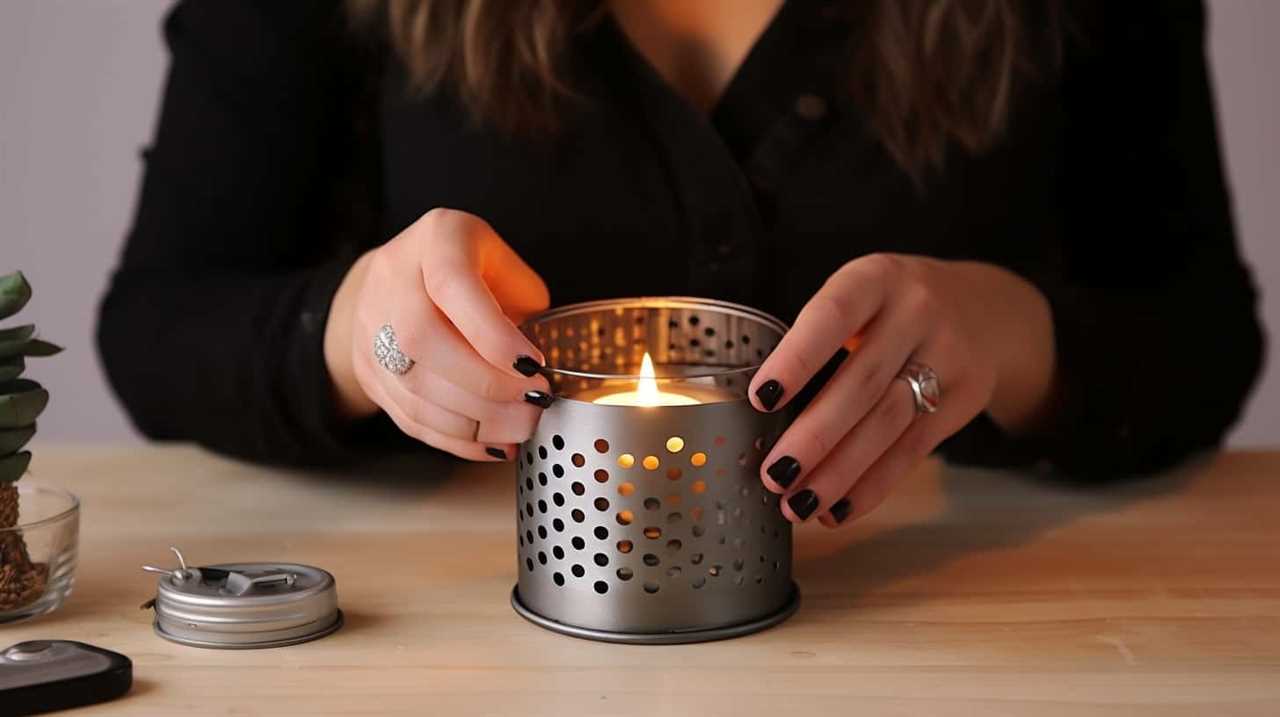
Here are four ways candles contributed to urbanization:
- Lighting: Candles provided essential lighting for homes, businesses, and streets, allowing urban areas to function even after dark.
- Workforce: The candle industry created employment opportunities, attracting people to urban centers in search of work.
- Commerce: The production and trade of candles stimulated economic growth, as they were in high demand for both domestic and industrial purposes.
- Innovation: The need for more efficient lighting sources led to the development of new technologies, further driving urbanization and industrial progress.
Candles, with their role in urbanization and economic impact, transformed cities into vibrant hubs of commerce and innovation during the Industrial Revolution.
Victorian Era Candle Etiquette
During the Victorian Era, individuals adhered to strict guidelines when it came to the proper use and display of candles. Candlelight played a significant role in social gatherings and was seen as a symbol of elegance and refinement. To enhance the ambiance, Victorian households used various types of candle holders, such as candelabra, candlesticks, and wall sconces. These candle holders were often made from materials like brass, silver, or crystal, adding a touch of luxury to the setting.
Candlelight etiquette was considered essential during this period. Candles were lit before guests arrived, and it was customary to extinguish them after the meal or event had concluded. It was also important to ensure that the candles burned evenly and didn’t drip wax, as this was seen as a sign of poor quality.
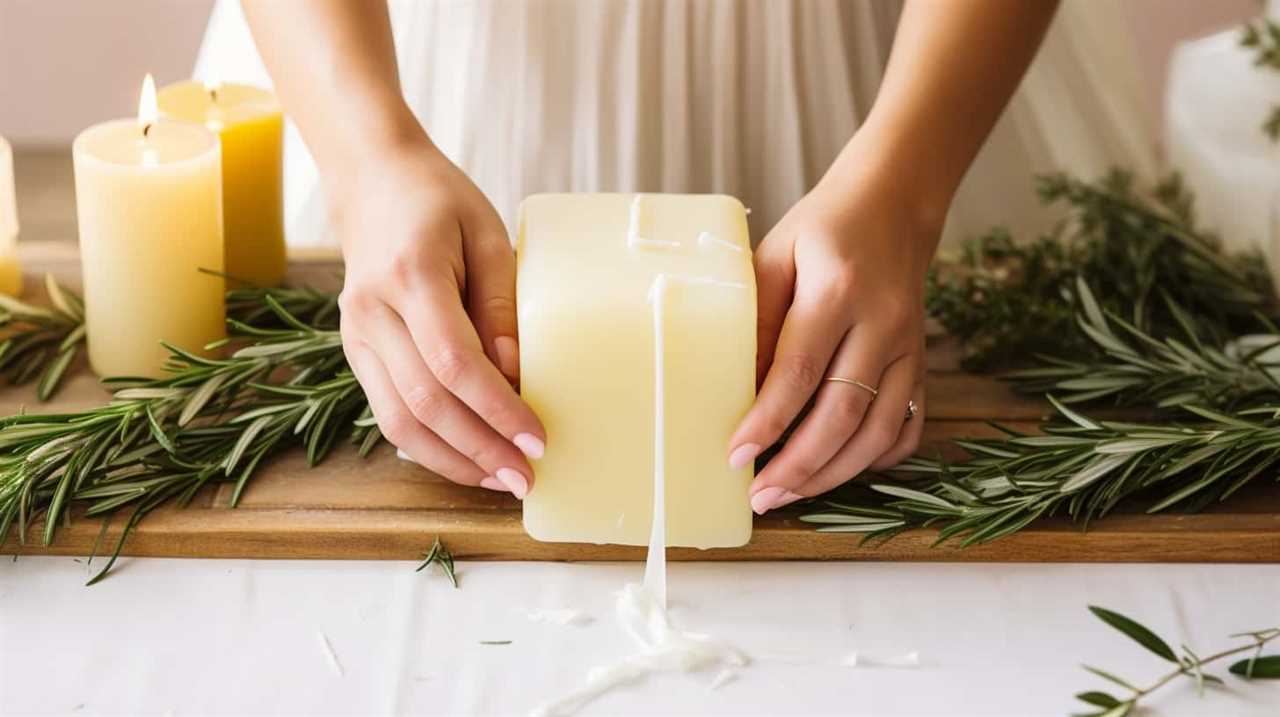
Following these guidelines allowed individuals to create a sophisticated and welcoming atmosphere in their homes.
Early 20th Century Decline
By the early 20th century, the popularity of candles began to wane as new sources of lighting emerged. This decline was influenced by several causes and cultural shifts:
- Introduction of electricity: The widespread adoption of electricity in homes and businesses provided a safer and more convenient alternative to candles.
- Industrialization: The rise of industrialization resulted in the mass production of cheaper lighting options such as kerosene lamps and gaslights.
- Changing lifestyles: With the advent of electric lighting, people no longer needed to rely on candles for tasks like reading or working at night.
- Safety concerns: Candles posed a fire hazard, and as awareness of safety increased, people sought out safer alternatives.
These factors, along with the advancements in technology and changing social norms, contributed to the decline of candles as a primary source of lighting in the early 20th century.
Mid-century Modern Revival
In the mid-century modern era, we witnessed a resurgence in the popularity of candles. As mid century modern design became popular in the 1940s and 1950s, candles became a key element in creating the retro home decor aesthetic. The clean lines and minimalist approach of mid century modern design embraced the use of candles as both functional and decorative pieces.
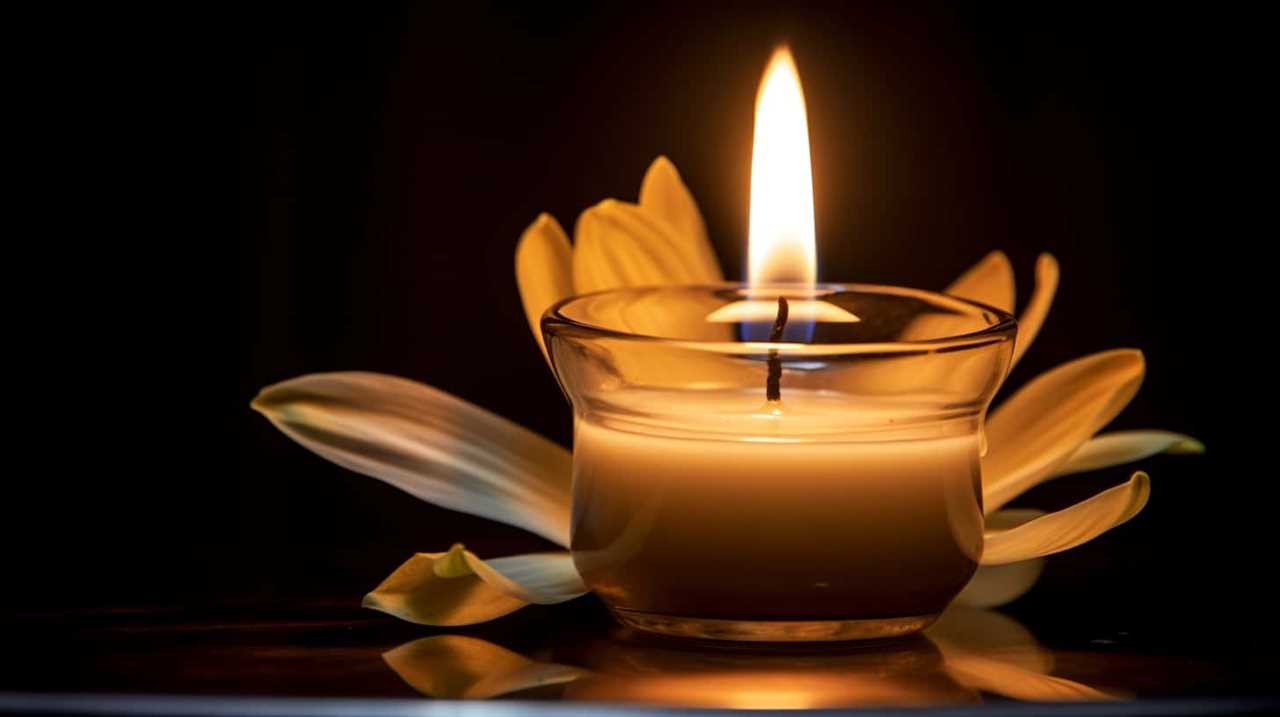
Candles were often placed in sleek, modern candle holders and strategically positioned throughout the home to create a warm and inviting atmosphere. With their soft, flickering glow, candles added a sense of coziness and intimacy to the mid century modern home.
Today, the mid-century modern revival continues to influence home decor trends, and candles remain a timeless element in creating a retro and stylish ambiance.
Candlelit Religious Rituals
When examining candlelit religious rituals, it’s important to consider the symbolism behind the use of candlelight.
Throughout history, candles have played a significant role in religious traditions, representing illumination, purity, and spiritual connection.

From ancient religious ceremonies to modern candlelit ceremonies, the use of candles continues to evoke a sense of reverence and create a sacred atmosphere.
Understanding the historical context and symbolism of candlelight in religious rituals allows us to appreciate its enduring significance in spiritual practices.
Symbolism in Candlelight
Throughout history, we’ve found profound symbolism associated with the warm glow of candlelight during religious rituals. Candlelight has been used to create a sacred atmosphere and symbolize spiritual enlightenment.
Here are some key points to consider:

- Candlelight symbolizes divine presence: In many religious traditions, candles are used to represent the presence of a higher power or divine beings. The flickering flame is seen as a manifestation of the divine energy.
- Candlelight enhances focus and contemplation: The soft, warm glow of candles helps create a serene and peaceful environment, allowing individuals to focus their thoughts and engage in deep reflection during religious rituals.
- Candlelight signifies purification and renewal: Lighting candles during religious ceremonies is often associated with the purification of the soul and the renewal of one’s spiritual journey.
- Candlelight represents hope and guidance: Candles have long been seen as symbols of hope, providing a guiding light in times of darkness or uncertainty. The flame serves as a beacon, illuminating the path towards spiritual enlightenment and understanding.
Historical Religious Traditions
As we delve into the historical religious traditions surrounding candlelit rituals, it becomes evident that the use of candles has played a significant role in various cultures and faiths.
Candle symbolism has been used as a powerful tool in religious practices for centuries. In Christianity, candles are often lit to symbolize the presence of God and the light of Christ. The flickering flame represents hope, guidance, and spiritual illumination.
Similarly, in Hinduism, candles are lit during puja ceremonies to honor deities and seek their blessings. The light from the candle is believed to dispel darkness and bring positive energy.
In contemporary religious practices, candles continue to hold great importance. Many individuals light candles during prayer and meditation to create a sacred atmosphere and enhance focus. The act of lighting a candle can also serve as a reminder of one’s spiritual connection and intention.
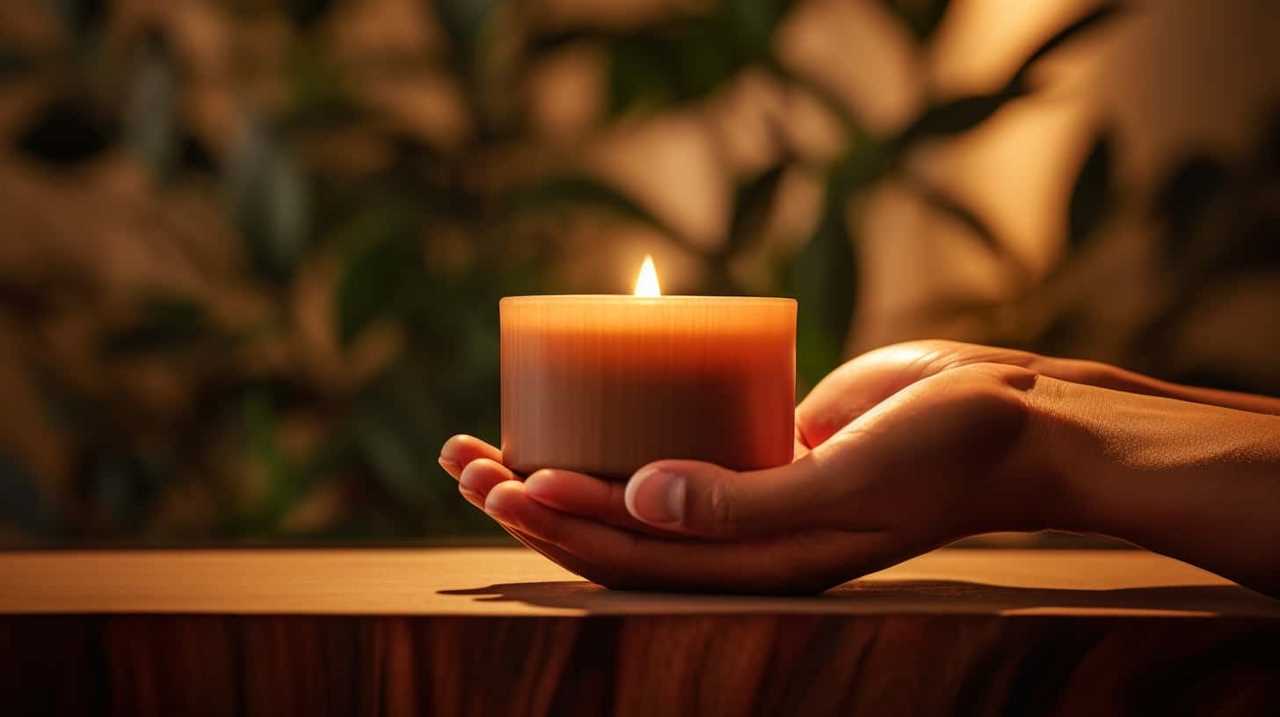
Modern Candlelit Ceremonies
In our exploration of candle usage throughout history, we find that modern candlelit ceremonies, particularly those of a religious nature, continue to be a significant part of many cultures and faiths. The warm and flickering glow of candles creates an ambiance that enhances the spiritual experience.
Here are some ways candles are used in modern candlelit ceremonies:
- Modern candlelit weddings: In contemporary weddings, couples often choose to incorporate candlelit ceremonies to symbolize unity and love. The lighting of a unity candle, where two individual flames merge into one, represents the joining of two lives in marriage.
- Candlelight meditation sessions: Many individuals and groups engage in candlelight meditation sessions to create a serene and calming atmosphere. The soft lighting of candles helps focus the mind and promotes relaxation and inner peace.
- Candlelit vigils: In times of sorrow or remembrance, candlelit vigils are common to honor and pay tribute to loved ones. The flickering flames serve as a symbol of hope, strength, and unity.
- Candlelit religious processions: Some religious traditions incorporate candlelit processions as part of their worship practices. Members of the congregation carry lit candles as they process through sacred spaces, symbolizing their faith and devotion.
Modern candlelit ceremonies continue to hold deep meaning and significance in various religious and cultural contexts. The use of candles adds a sense of sacredness and reverence, creating a memorable and meaningful experience for participants.
Candles in Modern Interior Design
We love incorporating candles into our modern interior design to create an atmosphere of warmth and relaxation. Candles not only provide soft, ambient lighting but also offer various benefits, such as aromatherapy and enhancing outdoor designs.
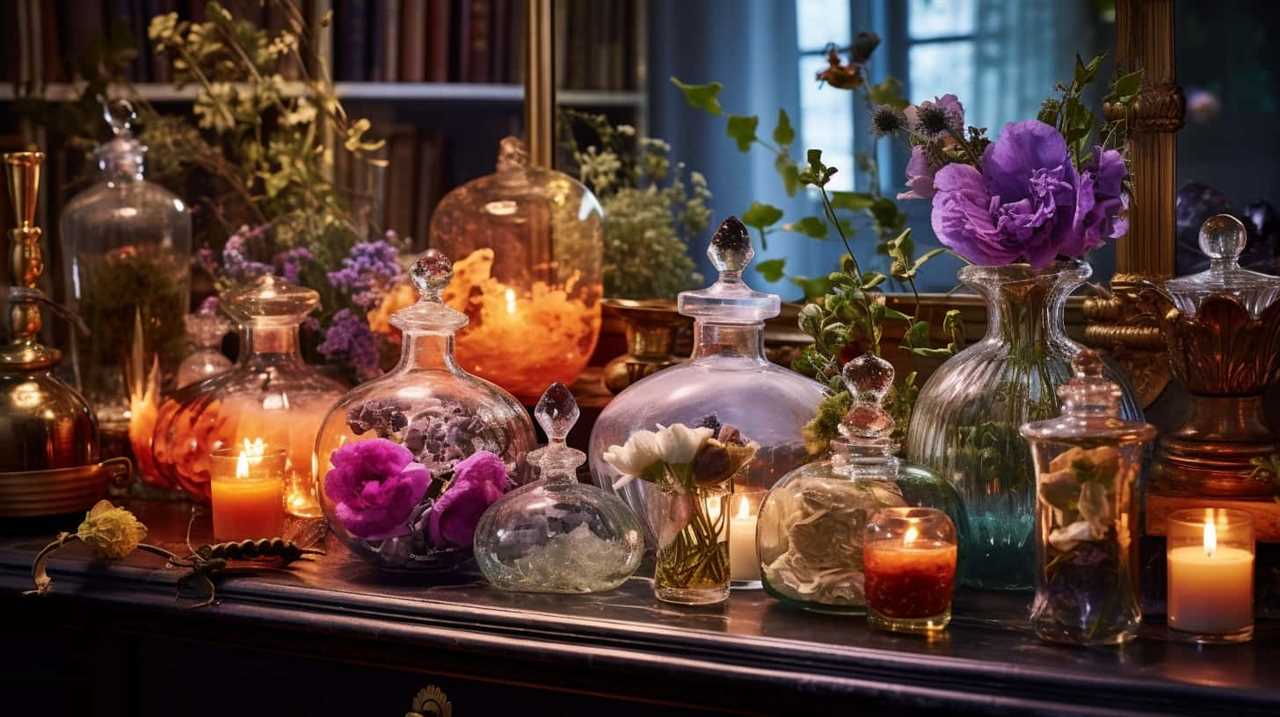
Aromatherapy candles, infused with essential oils, can help create a soothing and calming environment, promoting relaxation and stress relief. By strategically placing candles in outdoor spaces, such as patios or gardens, we can transform these areas into cozy retreats, perfect for intimate gatherings or quiet moments of solitude. The flickering candlelight adds a touch of romance and elegance to the overall design.
As we delve into the subsequent section about candle manufacturing techniques, we’ll explore how candles are crafted to achieve the desired effects in our modern interior designs.
Candle Manufacturing Techniques
When it comes to candle manufacturing techniques, there are several points to consider.
Traditional candle making methods have been used for centuries, involving the melting of wax and the pouring of it into molds.

On the other hand, modern manufacturing methods have introduced automated processes that streamline production and increase efficiency.
Additionally, sustainable production techniques have become more prevalent, with manufacturers focusing on using renewable resources and reducing waste.
These different approaches to candle manufacturing contribute to the wide variety of candles available in the market today.
Traditional Candle Making
Throughout history, people have frequently relied on traditional candle making techniques to manufacture candles. These techniques have been passed down through generations and continue to be used today. Traditional candle making involves sustainable production techniques that prioritize the use of natural and renewable materials.

Here are four key aspects of traditional candle making:
- Wax Selection: Traditional candle makers carefully choose the type of wax to use, such as beeswax or soy wax, based on its sustainability and environmental impact.
- Wick Preparation: The wick is an essential component of a candle. Traditional candle makers ensure that the wick is properly prepared and made from natural fibers, such as cotton, to promote clean and even burning.
- Hand Pouring: Traditional candle making often involves hand pouring the wax into molds or containers. This allows for greater precision and attention to detail.
- Natural Fragrances: Traditional candle makers often use natural fragrances, such as essential oils, to add a pleasant scent to the candles without relying on synthetic additives.
Modern Manufacturing Methods
The modern manufacturing methods of candle making involve utilizing advanced techniques and technologies to streamline the production process and improve efficiency.
One significant advancement in candle manufacturing is the development of modern candle fragrances. These fragrances are created using a combination of natural and synthetic ingredients, resulting in a wide variety of scents that can enhance the ambiance of any space.
However, it’s important to consider the impact of these fragrances on energy consumption. Manufacturing scented candles requires additional energy for the extraction and processing of fragrance ingredients. Additionally, the use of synthetic fragrances often involves the use of chemicals that can have negative environmental effects.
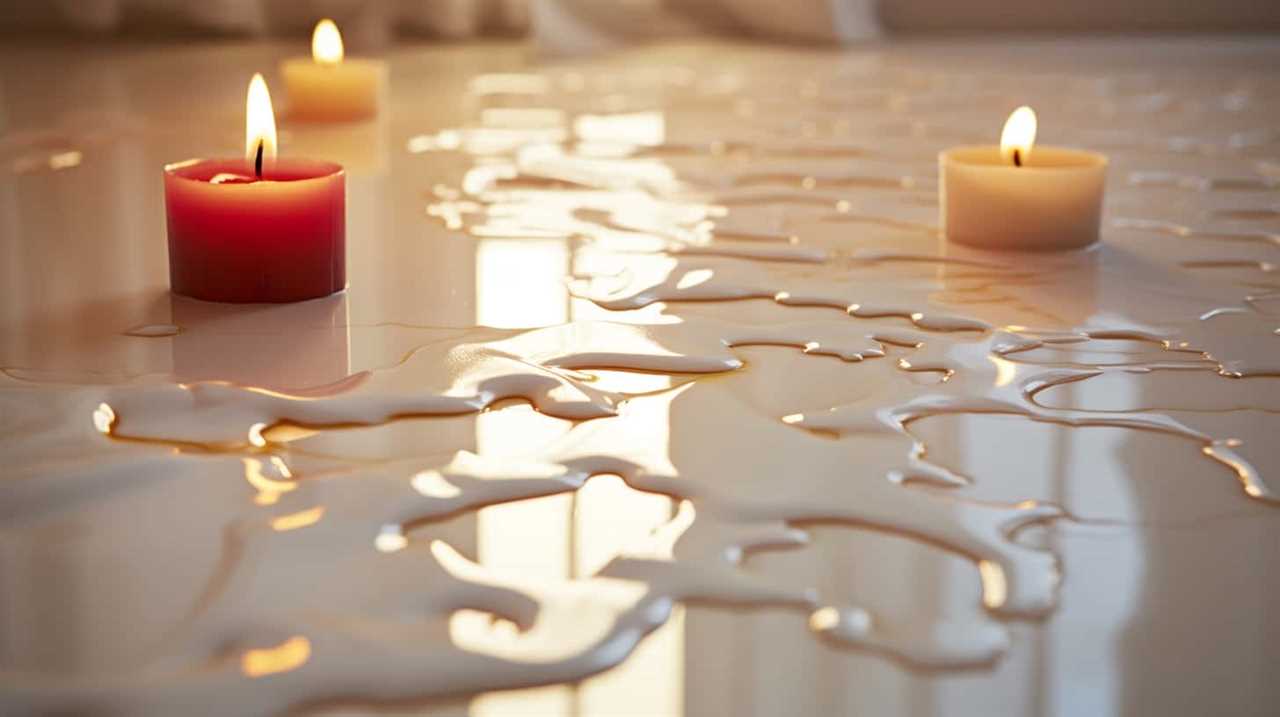
Candle manufacturers are now exploring more sustainable alternatives, such as using natural essential oils, to reduce energy consumption and minimize environmental impact.
Sustainable Production Techniques
To achieve sustainability in candle manufacturing, we prioritize the implementation of eco-friendly production techniques. Our commitment to reducing the environmental impact of candle production is reflected in the following practices:
- Use of natural and renewable materials: We source our wax from sustainable plant-based sources, such as soy or beeswax, which are biodegradable and don’t contribute to deforestation.
- Energy-efficient manufacturing processes: We’ve invested in modern equipment and technologies that minimize energy consumption during production, reducing greenhouse gas emissions.
- Recycling and waste reduction: We strive to minimize waste by recycling materials, such as excess wax and packaging, and by implementing efficient production systems that optimize material usage.
- Eco-friendly packaging: We choose packaging materials that are recyclable or made from recycled materials, reducing the overall environmental impact.
Environmental Impact of Candles
Exploring the environmental impact of using candles reveals potential concerns for sustainability and air quality. When it comes to candle usage, it is important to consider the effects on the environment and take steps towards minimizing our carbon footprint. One way to do this is through candle recycling programs, where used candles can be collected and repurposed. By recycling candles, we can reduce the amount of waste that ends up in landfills and promote a more sustainable approach to candle usage. Additionally, choosing candles made from natural and renewable materials can further contribute to reducing our environmental impact.
To illustrate the impact of candle usage, consider the following table:
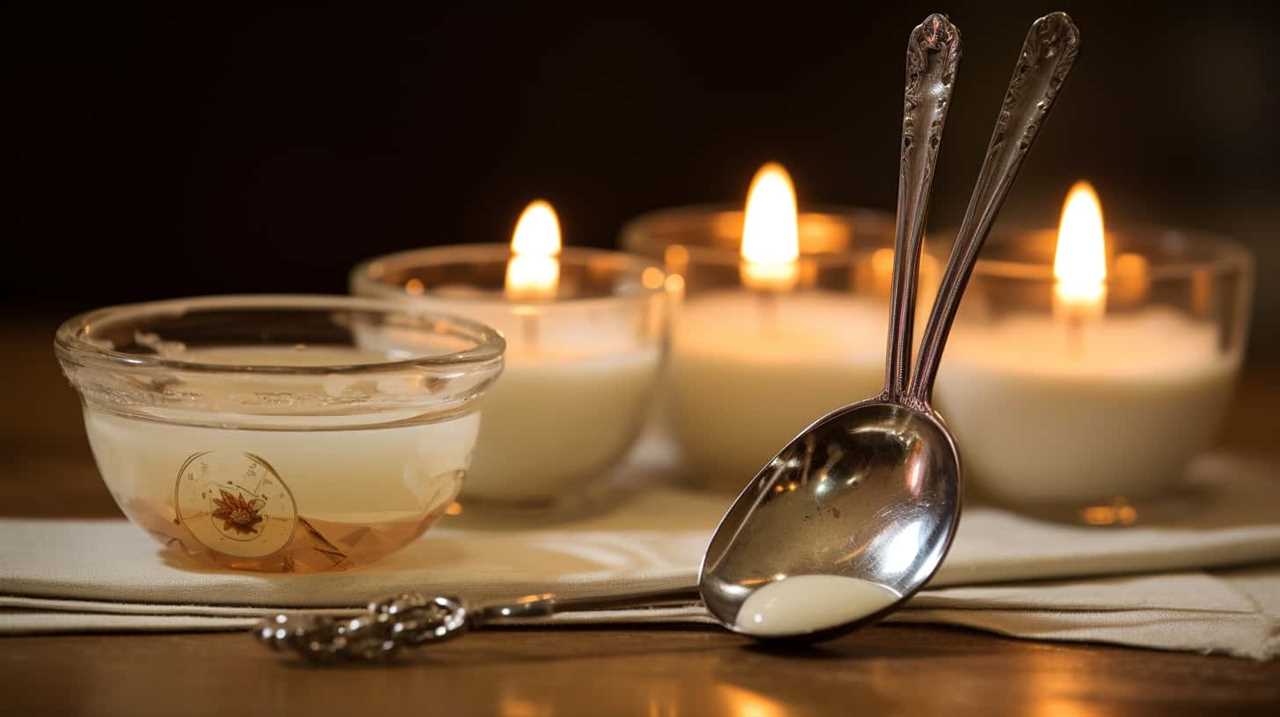
| Environmental Impact | Description | Emotional Response |
|---|---|---|
| Air Pollution | Burning candles can release pollutants such as soot and carbon dioxide into the air. | Concern for the quality of the air we breathe. |
| Energy Consumption | Producing and transporting candles requires energy, contributing to greenhouse gas emissions. | Awareness of our energy consumption and its impact on the environment. |
| Waste Generation | Discarded candles contribute to waste accumulation in landfills. | Desire to reduce waste and promote recycling. |
Considering these factors, it is crucial to find ways to minimize the environmental impact of using candles and prioritize sustainable practices. Transitioning into the subsequent section about the future of candle usage, we can explore innovative solutions that address these concerns and pave the way for a more eco-friendly approach to candle lighting.
Future of Candle Usage
As we look to the future, embracing sustainable practices and incorporating innovative technologies will shape the evolution of candle usage. The future of candle usage holds great potential for positive change and advancement.
Here are some key factors that will impact the future of candle usage:
- Enhanced sustainability: With a growing focus on environmental consciousness, candle manufacturers are investing in sustainable materials and production methods. This includes using renewable resources and reducing carbon emissions throughout the production process.
- Smart technology integration: Innovative technologies, such as smart home automation, will revolutionize the way we use candles. Imagine controlling the fragrance, color, and intensity of your candles through a smartphone app.
- Customization and personalization: Consumers are increasingly seeking unique and personalized products. The future of candle usage will offer customizable options, allowing individuals to create their own scents, shapes, and designs.
- Safety advancements: Technology will play a crucial role in enhancing the safety of candles. Fire-resistant materials, improved wicks, and smart monitoring systems will ensure that candles remain a safe and enjoyable experience.
These developments won’t only enhance the candle experience but also contribute to a more sustainable and personalized future.
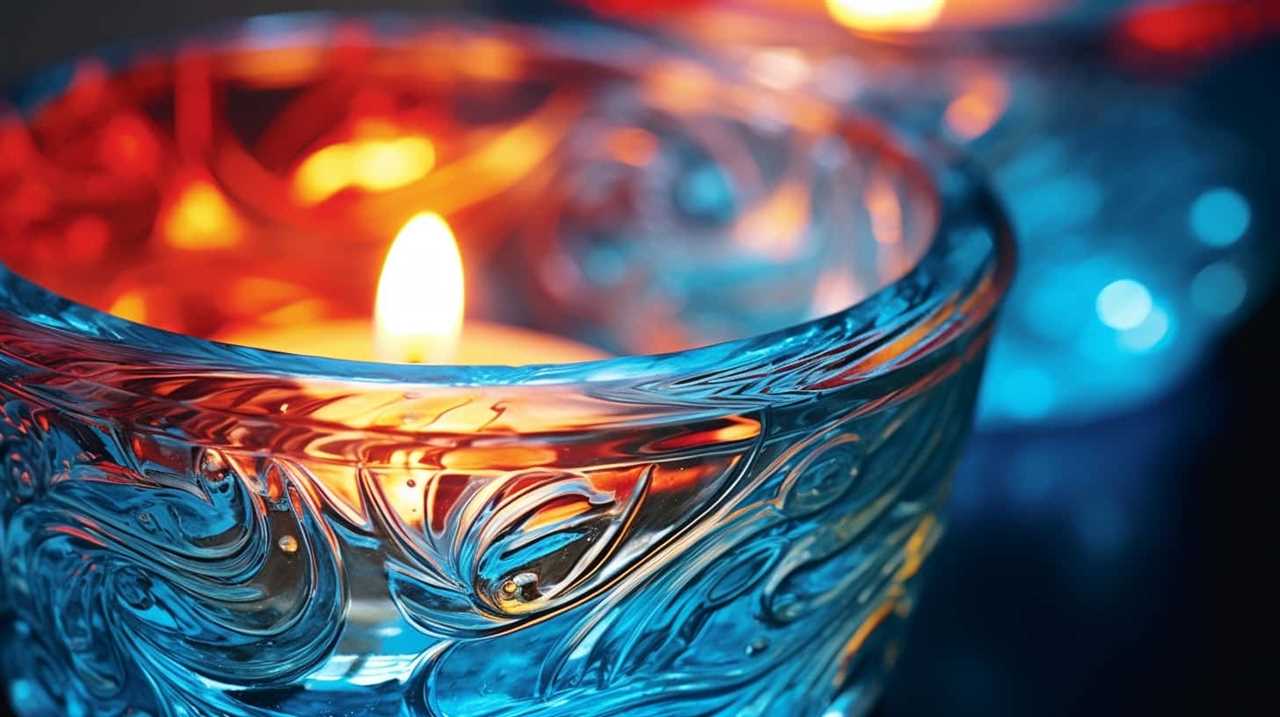
Frequently Asked Questions
How Were Candles Used for Religious Rituals in Ancient Civilizations?
In ancient civilizations, candles were used for religious rituals as a symbol of divine presence and enlightenment. Candlelight meditation allowed individuals to focus their minds and connect with the spiritual realm.
What Were the Most Common Materials Used to Make Candles During the Roman Era?
During the Roman era, candles were commonly made from materials such as tallow, beeswax, and bayberry wax. These ancient candle making techniques allowed for the production of candles that were used for various purposes, including lighting and religious ceremonies.
How Did Candle Etiquette Change During the Victorian Era?
During the Victorian era, candle etiquette underwent significant changes. Social customs placed great importance on the proper use of candles, especially during candlelight dinners. The way candles were lit and extinguished became a symbol of refinement and elegance.
What Factors Contributed to the Decline of Candle Usage in the Early 20th Century?
Factors such as the invention of electric lighting and the availability of alternative light sources contributed to the decline of candle usage in the early 20th century. These changes revolutionized the way people illuminated their homes, leading to a decrease in candle usage.
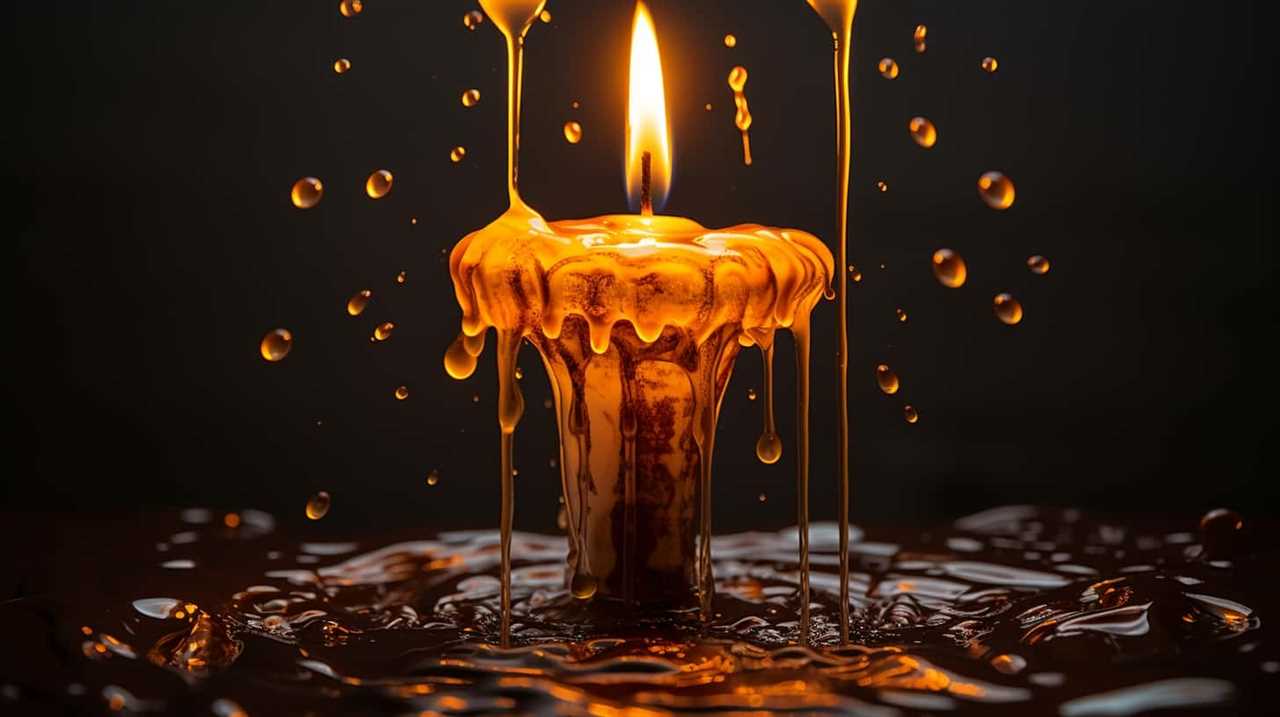
How Have Candles Been Incorporated Into Modern Interior Design?
Candle scents and holders have become integral to modern interior design. They add ambiance and a sense of relaxation. Different scents can evoke specific moods and create a welcoming atmosphere. Candle holders come in various designs, enhancing the aesthetic appeal of any space.
Conclusion
In conclusion, candles have played a significant role throughout history, from their prehistoric origins to their modern-day use in interior design. They’ve provided illumination, decoration, and even spiritual meaning in various cultures and time periods.
Despite advancements in technology, candles continue to be valued for their beauty and ambiance. However, it’s important to consider the environmental impact of candles and explore sustainable alternatives for the future.
As the saying goes, ‘Where there’s smoke, there’s fire,’ and we must strive to find a balance between tradition and sustainability.




